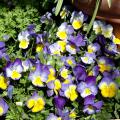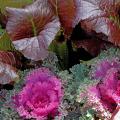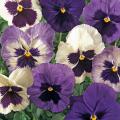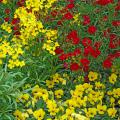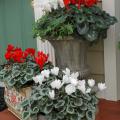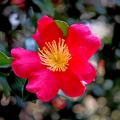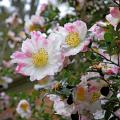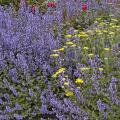Southern Gardening from 2006
By Norman Winter
MSU Horticulturist
Central Mississippi Research & Extension Center
The cooler weather of October means one thing -- it's pansy planting time in the South. I was on the coast the other day and one of the restaurants already had quite a display. There are so many great new selections that you may have a hard time making a decision. That's where I come in, and I want to suggest this fall's Mississippi Medallion Award-winning Ultima Morpho.
By Norman Winter
MSU Horticulturist
Central Mississippi Research & Extension Center
The shopping frenzy for winter plantings has begun, and as you shop for pansies and snapdragons, keep in mind flowering kale, cabbage and mustard.
With their foliage in brilliant shades of lavender, purple, pink, red and white, remember that kales, cabbages and mustards add pizzazz to the fall and winter garden like no other plants can do. This isn't a temporary show either. These tough plants give a “wow-effect” to gardens from October though April.
By Norman Winter
MSU Horticulturist
Central Mississippi Research & Extension Center
During a recent greenhouse visit, I could pick out my favorite mix of pansies while I was still 30 or 40 yards away. It's been several years since a mix of any certain crop stirred such frenzy in me, but that is precisely what happens every time I look at Coastal Sunrise.
The Coastal Sunrise mix is in the Matrix series. The Matrix series only hit the market last year, and already they have skyrocketed in popularity for several good reasons.
By Norman Winter
MSU Horticulturist
Central Mississippi Research & Extension Center
My repeated encouragement to take advantage of pansy planting time in the South may have motivated you to purchase these beautiful cool-season plants, but also left you wondering what to plant with them. Pan American Seed, one of the industry leaders, has come up with a novel approach to this question called Pansy Pals.
By Norman Winter
MSU Horticulturist
Central Mississippi Research & Extension Center
With the holidays practically upon us, time is running short to plant cool season flowers that will welcome friends and family. Serious frost across much of the state took the beauty from some favorite perennials. In many cases, these plantings are right near the front door, porch or main entryway.
By Norman Winter
MSU Horticulturist
Central Mississippi Research & Extension Center
When you think about holiday decorating, think about your front door. I recently urged readers to consider holiday plantings near the front entrance to a home. Now I want to take everyone up the steps, on the porch and even to the door.
By Norman Winter
MSU Horticulturist
Central Mississippi Research & Extension Center
Just a couple of months ago, many of us worried the drought was going to drop most of the leaves before fall colors had a chance. Today, we are awestruck by the awesome colors on display.
It has been and is a banner year all over the state. In late October, I was with my son at a golf tournament in Tupelo, and it felt like we were in North Carolina.
By Norman Winter
MSU Horticulturist
Central Mississippi Research & Extension Center
This year's poinsettia crop is without a doubt the best I have ever seen, and as usual, our growers are on top of the curve in quality, variety and innovation.
In late summer, I told many of you via television and newspaper articles about the hot new Diamond Frost euphorbia. This is a tough-as-nails plant that produces hundreds of tiny flowers and is related to the poinsettia.
By Norman Winter
MSU Horticulturist
Central Mississippi Research & Extension Center
Poinsettias, cyclamen and kalanchoes rank as the most popular plants for decorating or gift-giving at this time of the year. This year, consider another plant that is readily available at most garden centers and florists: the bromeliad.
When I mention bromeliad, what is your first thought? Is it of a finicky, hard-to-grow tropical? Do you think it might be impossible to get it to rebloom? If those are your impressions, I want to help you reconsider.
By Norman Winter
MSU Horticulturist
Central Mississippi Research & Extension Center
It's hard to pass up a shrub with a Christmas name, especially one with the festive colors, that blooms during the holiday season. Yuletide camellias can be found in many of the same places the more common Camellia sasanquas are located, such as near old homes and public buildings.
By Norman Winter
MSU Horticulturist
Central Mississippi Research & Extension Center
Mississippi is legendary when it comes to camellias and should soon have some stops along the American Camellia Society's upcoming National Camellia Trail. This trail will begin in the Pacific Northwest, move down the Pacific coast before turning east toward the Gulf states, then proceed north along the eastern seaboard.
By Norman Winter
MSU Horticulturist
Central Mississippi Research & Extension Center
The deodar cedar is one of my favorite trees in larger landscapes. Oddly enough, its country of origin is seen daily in the headlines. Can you guess? It's from Afghanistan and the Himalayas.
To me it's from Lucedale. Some of our great woody ornamental producers grow this tree. Most of you probably think of me as a tropical nerd or flower nut of some kind, but I'll readily admit that I may wake up a conifer freak some morning.
By Norman Winter
MSU Horticulturist
Central Mississippi Research & Extension Center
Those who have grown Six Hills Giant catmint will want to make room for Walker's Low catmint, the 2007 Perennial Plant of the Year. Introduced in 1988 in Europe, Walker's Low has become increasingly popular with each passing year.
I am impressed with the variety of plants chosen by the Perennial Plant Association. Some of my favorites have been Becky Shasta daisy, Firewitch dianthus, Butterfly Blue scabiosa and Sunny Border Blue veronica.
Pages
- « first
- ‹ previous
- 1
- 2
- 3

